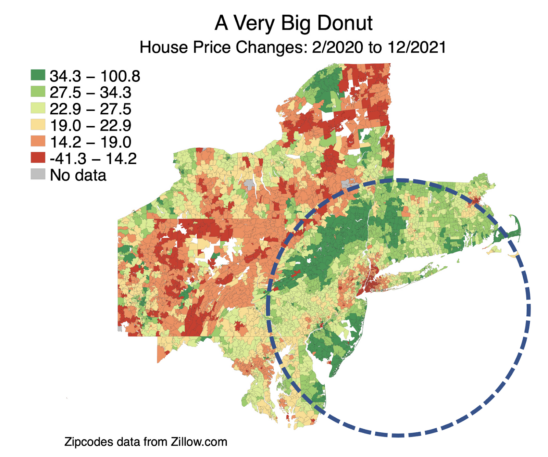The freedom to work remotely has prompted nearly 10% of Americans to make plans to move, according to a new survey from Upwork, creator of the popular freelance marketplace.
Based on responses from over 23,000 Americans, it argues the WFH phenomenon is starting to have a clear geographic impact on the country, pulling workers farther and farther away from urban cores. Upwork says 2.4% of American adults (which it estimates to be 4.9 million people) say they’ve already moved since 2020 as a result of remote work, but almost four times that number—9.3%, or almost 19 million—are planning to move. It notes people’s plans shouldn’t be given as much weight as what they’re presently doing, but this number still represents a 50% jump since Upwork’s last survey, in October 2020.
The most striking part of the data, however, is where people are moving. Upwork asked how far respondents were traveling when they moved. Many moves were local, but the surprising discovery was that 28% were to a new home that was more than four hours away, and another 13% were between two and four hours away—distances “outside the range of what many people would think is commutable.”
This pattern seems to expand on the so-called “donut effect” premise—a helpful visual concept by Stanford researchers Arjun Ramani and Nicholas Bloom, which describes the migration out of urban areas and into the suburbs. These moves are for any number of personal reasons, but the explanation for why they’re occurring now is that remote work made them possible.
For additional context, Upwork also looked at real-estate data: home price changes on Zillow for zip codes in the New York City metropolitan area and the Bay Area between February 2020 and December 2021, to see where prices have gone up and where they’ve gone down. While it was largely understood that 2021’s real-estate prices were incredibly high, Upwork says Zillow’s data show the price dropped for most zip codes clustered at the center of these two metro areas, yet increased for zip codes farther out—sometimes even doubling, at the extreme edges of the area.
Upwork calls this “an important caveat to the donut effect,” namely that “the donut can be huge.” Using the Zillow data, New York’s donut would seem to include “large swaths of Pennsylvania and New Jersey,” including “places like the Poconos, Allentown, and south Jersey.” That’s not exactly the donut effect Ramani and Bloom describe, but Upwork argues the data support that people are making “fairly long-distance moves to rural, low-cost places well beyond the New York City suburbs.”

Consider a professional who is temporarily working remotely for their company based in New York City. That professional is unlikely to move somewhere like Montana, as they could be recalled to the office permanently at any time. Even when an employer has promised remote work forever, uncertainty remains. What if they want another job in the future? Will they be limited to the local labor market in Montana?
Assuming people are staying (relatively) local, remote work’s effects in spreading new economic activity across the U.S., and “away from superstar cities,” might end being less pronounced, the report concludes.
So what does that mean for the future of work? “The reality is we are just at the beginning of seeing the impacts of remote work,” Upwork’s report says, concluding perhaps it’s smartest to wait and watch those 19 million Americans who haven’t yet moved, but plan to.
Recognize your brand’s excellence by applying to this year’s Brands That Matter Awards before the early-rate deadline, May 3.
